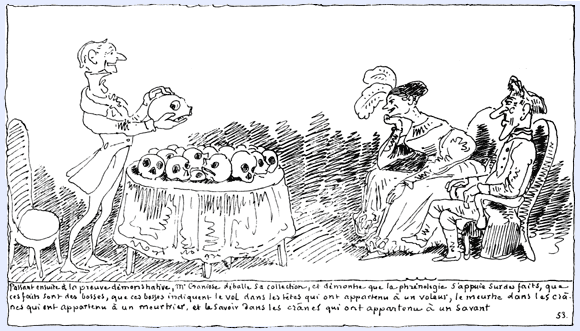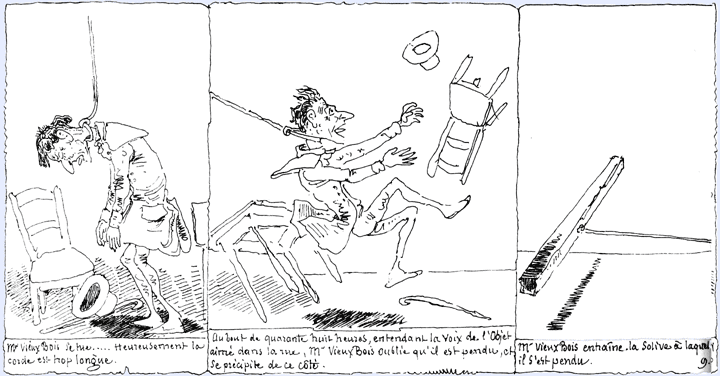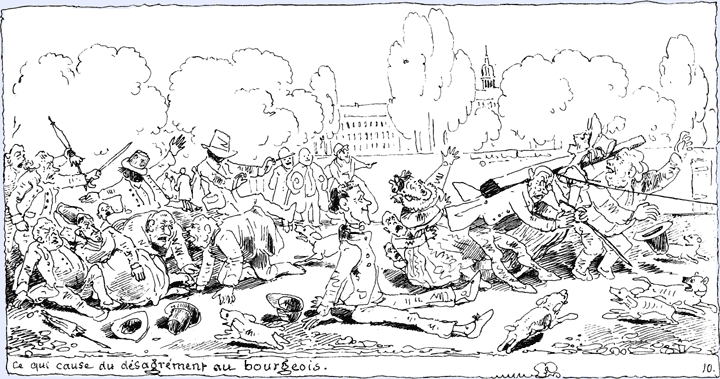

| May 1999 |
|
| Rodolphe Töpffer | |

You may remember Töpffer from Scott McCloud's Understanding Comics. He's a Swiss teacher, writer, and cartoonist who published a series of seven proto-comics in the last century:
Histoire de M. Jabot, 1833 (drawn 1831). M. Jabot, a dandyish bourgeois, tries to enter society; and after a series of misadventures marries the woman who lives next door.There was a mention of Töpffer on rec.arts.comics.alternative last year-- one of those endless discussions on when comics started. I hate to be in no position to offer an opinion; so I was happy to find a complete edition in Montréal. I have no idea where you can find any, though McCloud mentions an English edition of M. Crépin published in 1965.M. Crépin, 1837. M. Crépin suffers the follies of various tutors he hires for his children.
Les Amours de M. Vieux Bois, 1837. M. Vieux Bois's long and absurd journey toward matrimony.
M. Pencil, 1840 (drawn 1831). A series of catastrophes, starting with the wind blowing away an artist's sketch and nearly leading to universal war.
Le Docteur Festus, 1846 (drawn 1831). The doctor tours the world, unknowingly causing numerous upsets.
Histoire d'Albert, 1845. A somewhat dull young man tries various careers before ending up as a radical journalist.
Histoire de M. Cryptogame, 1845 (drawn 1830). A lepidopterist exchanges his dull girlfriend for another, by methods including shiploads of pirates and a capacious whale.
The father of the modern comic in many ways is Rodolphe Töpffer, whose light satiric picture stories [...] employed cartooning and panel borders, and feature the first interdependent combination of words and pictures seen in Europe. ...Töpffer's contribution to the understanding of comics is considerable, if only for his realization that he who was neither artist nor writer had created and mastered a form which was at once both and neither.And in explaining himself, Töpffer himself certainly writes like someone inventing a new genre:
This little book has a mixed nature. It is composed of a series of autographed pictures. Each picture is accompanied by one or two lines of text. The pictures, without this text, would have only an obscure meaning; the text, without the pictures, would mean nothing. Together they form a sort of novel, all the more original in that it does not resemble a novel more than any other thing. The author of this little oblong volume [Töpffer is being coy here] is not known. If he is an artist, he draws badly, but he has some skill in writing; if he is a writer, he writes only moderately well, but in recompense he has a good amateur's drawing skills.Autography was a sort of lithography which allowed the artist to draw with a pen on specially prepared paper. At the time, "serious" printed art was engraved. Part of the claim that Töpffer invented comics rests on this process, I think. One can, with difficulty, engrave humorous scenes. But an artist's own pen-strokes are more conducive to light humor; and their directness to the nature of the comics medium, which does not-- like writing or painting-- insinuate itself into the mind, but stabs its way in through the eyes and heart.
My feeling is that Töpffer on the whole is about 75% of the way toward being comics. It has the panel structure, the interrelation of pictures and stories, the McCloudian harmony between simple, satirical prose and sketchy art. Most tellingly, perhaps, the pacing is that of comics. Töpffer occasionally narrows the panels to speed up the action (a technique revitalized by Dave Sim), or flashes quickly between characters, in a way that would be nearly impossible in straight text.
But it's missing something. The last step was taken by the American comics later in the century, which got rid of the running narrative once and for all, and put the dialog inside the panel.
It was an important step. Even Töpffer's short texts are third-person and descriptive, and they slow down the story, and have a distancing effect. There is no dialog in Töpffer. If you've read Little Nemo from the beginning, you may have sighed in relief when McCay finally abandoned the running text.
Hergé as well, a century later, felt the additional power thus gained. He learned from American comic strips (and from Zig et Puce) how "text and image [could be] mutually completed, to form a new language" (Entretiens avec Hergé, Numa Sadoul, p. 29). Hergé's French publishers initially published Tintin with captions underneath each panel-- they were afraid people wouldn't get it. He had to protest vociferously before they stopped it. This sort of resistance to the integrated panel is evidence that Töpffer is not pure comics, though he's close.
All the stories are light satire. Some are absurd adventures, full of slapstick; a few are more naturalistic. Töpffer was a conservative, which in those days meant taking a dim view of newfangled ideas like democracy and upstarts like the middle class. (He helped found a conservative newspaper.) His politics comes out strongest in the story of Albert, the eventual radical journalist; but Töpffer is never really malicious. Like Molière, he seems to be more amused than angry at the posturings of the bourgeois attempting to rise in the world; and he can certainly not be accused of fawning on the clergy or aristocracy... witness the cross-dressing mayor in Dr. Festus, or the dim, wigless abbot in M. Cryptogame.
Here's a sampling of Töpffer at his most comics-like, from the romantic trials of M. Vieux Bois in search of his "Loved One":

| ||
| Mr. Vieux Bois kills himself. Fortunately, the cord is too long. | After forty-eight hours, hearing the voice of the Loved One in the street, Mr. Vieux Bois forgets that he has been hanged, and rushes in that direction. | Mr. Vieux Bois drags along the beam he has been hung from. |


| |
| As well as to the national guard. | Mr. Vieux Bois almost reaches the Loved One. |
The art is cartoony by period standards-- somewhat elaborate, perhaps, by ours. In fact, I'm not sure I agree with McCloud about Töpffer mastering "cartooning", and by implication the power of iconic identification; his art is rather that of the caricaturist, following in the footsteps of Hogarth and Rowlandson.
He uses zigzag lines for shading, but would have appreciated, I think, the greater mechanical possibilities open to later artists.
The stories are also a glimpse into early-19C Europe. It's a more rural world; the clothes are strange; the class divisions are strong; and one's horizons rarely go beyond the regional. The preoccupations are perennial, and low-tech: getting ahead in society; education; finding or eluding a beloved; touring; staying one step ahead of the local constable. A few 'modern' elements intrude-- telegraph wires, the radical newspaper started by Albert-- but modernity was still mostly a political idea, and science an ivory-tower eccentricity.
